Tecalpulco
Tecalpulco on a high hilltop looking out –
over an enormous vista in all directions.
The blue tile dome of the temple shines
under the radiant orb of Mexico.
Legends say they came centuries ago by underground cavern.
The rivalry with low-lying Taxco El Viejo goes back in time.
Tales say that the Tecalpulcans won the right to their hilltop
for having hung the bell in Taxco El Viejo’s temple
by the powers of heroic preColumbian magic.
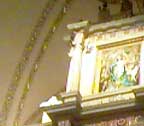
Tecalpulco: Giraffe-like bonete trees dangle their pod fruit
high above in silhouette against a cerulean sky.
Slab stone doorways, and doors of hewn wood,
doors of hand wrought steel. Brick, cinder block and adobe houses
with red tile roofs and earth hearths with women making tortillas
out of corn that was grown by the family, soaked in lime water overnight,
and ground in the morning light of eternal village life.
Mortarless stone walls eight and ten feet high;
line the streets and fence the fields and yards.
Underfoot: A stone paved street, going up to the Zocalo,
on out past the football field, past the High School, and the Cemetary,
the stone paving turns to a dirt highway out past
Santiago Temixco: bandit country! The Pepsi and Pan Bimbo trucos
are armed. And on to the mango and mamuey groves
and cool swift-flowing river of Paintla.
From the Zocalo at the center of Tecalpulco looking north, far away –
against the dark mountains one can see a crease of lights or white shadows:
Taxco. A part of the city is visible at a distance, way above.
Taxco is at 5800 feet altitude; Tecalpulco 4600. This is the southern drop off
of the great central altiplano, the northern Guerrero escarpment.
Tecalpulcans are indigenous native Mexicans,
rainy seasonal farmers.
Most families plant corn, beans, and squash
in the wet months of summer.
In the dry months of December through May,
the fields are a dusty desert
parched with thorny bush vegetation.
The natives are adept rock masons
The builder surveys the rocks strewn on the ground,
he picks up the one he sees will fit,
packs it into the place where it will go
and proceeds to select another.
In mortarless construction, the rocks need to be expertly tied together
and balanced; all this, the village stone-worker does in single vision;
never does he pick up a stone, then put it down, look around for another.
Hernan Cortez, the Conqueror of Mexico, opened the first silver mine
in Taxco in the early 1500s. The mines have been in production, now,
for five hundred years. Today the mines are the number two employer
in Tecalpulco with 64 men working down there. The miners are paid
by the mining company, $40 to $50usdollars for six day week. However
since five years ago, the mines have been closed, due to a miner’s strike.
The leading employer in Tecalpulco is the United States.
Today, according to the village Comisario,
more than 200 adults of the village
are up at the Northern neighbors’ working as wetback labor
mostly in Phoenix and Chicago, California, Florida, North Carolina
In the 1940s, Tecalpulco was a remote provincial village.
In the quiet hours of the morning,
the boys would stand near the mill
to watch the girls
when they were allowed out of the parents’ house
to grind corn or draw water.
Youth would make elaborate very fine signs to signal their intentions
to each other. With the infinite subtle beauty of youthful attraction,
love without words grew until a meeting could be managed.
Sometimes, a boy and a girl would elope
and no one knew that they even knew each other!
In the patios of the houses,
the people were making mirrors
cut out of tin sheet with metal shears.
The rustic artisans cut up thin tin into strips,
curled them and soldered these tin curls
on to the mirror frame surface as ornament.
And they made masks:
Shining, evocative, preColombian visages.
Sometimes the masks had eyes fashioned out of bone,
with a bit of polished clam shell inlayed as the pupil.
In the nineteen fifties the silver jewelry production of Taxco
expanded dramatically as a long-term result
of the intervention into Taxco
of a Tulane University architecture professor by name William Spratling
one more gringo who fell in love with the Mexican people
he stayed to established the first modern silver shop *Las Delicias*.
Today Spratling signed silver is highly collectible and reknowned
for the technical quality of execution and simple power of design.
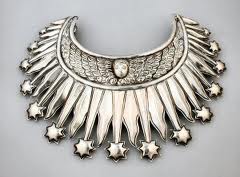
William Spratling Original
This tradition has been recognized as among the highest quality
fine silverwork in the world, on account of its expressive vitality
and technical execution of innovative wood, stone inlay into silver.
In the 1950’s hundreds of families in Taxco supported themselves
by silversmithing. So the population of Taxco became the serendipidous
beneficiary of Spratling’s genius and willingness to give to others.
http://www.burchardgalleries.com/auctions/2009/jul2609/01images/tl164_1.jpg
The general acceptance of the Spratling silver jewelry product
by the US and European market, also the burgeoning domestic market
of the growing tourist industry made Taxco into the ‘Silver City’;
a city of silversmiths, with generation upon generation of hammerers,
of polishers, arc saw cutters, solderers, casters, filers, and stonesetters.
Taxco, with its perfect climate and picturesque aspect
was in the fifties the scene of a Robert Mitchum film
and for a while was something of an art crowd hangout.
In the sixties, Tecalpulco’s tin mirrors and frames
sold through tourist stores in Taxco.
The Tecalpulco craftsmen were also making
a flexible fish ornament overlaid in abalone shell.
The larger fishes had a heavy duty mouth fashioned for bottleopener.
The fish were built on tin sheet salvaged from tin cans.
The artisan would work the shell material
on the edge of a carborundum wheel
mounted on a small bench motor
tied to a lard can filled with cement,
gluing on the abalone segments one by one
as she or he had shaped it.
Abalone shell had been a prized material since the Toltecs
in every Mesoamerican tradition of artifact. Spratling combined abalone shell
with rosewood and ebony in some of his great jewelry art.
In the sixties, the abalone shells were huge, and saturated with iridescent
blue green brilliance. The beautiful natural abalone overlaid on tin can sections
led to a fateful innovation Combining the town tradition of tinsmithing
with the abalone carving technique of the flexible fish ornament production
emerged: the Abalone Shell Belt Buckle for Western style 1 ½ inch leather belt.
The Tecalpulcan craftspeople produced about thirty or forty
per week per craftspersonof these belt buckles, in their backyard workshops.
In the seventies came the Abalone Shell Bracelet,
with perfect delicate eight petal daisy mother of pearl flower
in a iridescent bluegreen background
of shaped and pieced together abalone.
A demand for the new Tecalpulco jewelry products built up,
as merchants sought source to replace sold product.
Taxco merchants, with access to retail and wholesale customers organized
orders for production by the villagers.
Buyers started flying into Mexico looking for the product.
Hundreds of families in Tecalpulco, Dolores, Taxco El Viejo,
Cerro Gordo, El Ejido Paintla, etc.
were supporting their needs by handcraft jewelry production.
In the eighties, Tecalpulco experienced a boom in demand
for its products and all the other villages in the area started making
alpaca abalone jewelry; also hundreds of shops in Taxco
turned to alpaca abalone shell jewelry production.
A vibrant wholesaler sector grew up in Taxco.
Some wholesaler families became quite wealthy on the strength
of the abalone shell jewelry boom that continued the entire decade.
Those humble, attractive shell mosaic inlays of Tecalpulco
gained worldwide acceptance and by 1984,
the alpaca abalone shell earring was handcrafted,
and the boom re-doubled, and it went on until it filled showcases and racks
in every last mall kiosk in New Jersey and Stockton, Vancouver
and Daytona Beach, Hawaii, South Africa, Chile, Germany, Japan
The beautiful shell mosaic handcraft of Tecalpulco
was everywhere in the world!
The nineteen-nineties: fashions changed
and the curtain rung down on the handcrafts of Tecalpulco.
The nineties didn’t want flowers or pretty things,
it wanted tatoos, virtual entertainment, and Nike.
The tastes of more mature ladies who had oohed and ahhed and had
collected abalone earrings transmuted into aromatherapy and crystals.
At the same time, ferocious costume jewelry competition came in
from the Orient, taking over the traditional export and domestic markets
of the Mexican artisan. Every year the abalone jewelry was harder
to sell, and the buyer would pay less for it, than the year before.
Many local artisans gave up jewelrymaking,
still some don’t know how to do anything else;
a lot support their family on earnings from handwork;
however poorly paid, it is often
the only source of income for families.
Gradually the artisans were forced to abandon their homes
and the young and active ones have gone North as wetback labor.
Others, forced by the necessity of providing for their families,
have surrendered their miserable fate to the tombs of the mine.
The process of globalization of markets caused a grave crisis
in the countryside of Mexico, that has borne down terribly
all of this last decade. Colera re-emerged in the 1990’s
after having disappeared entirely in the 20th Century.
Dengue fever too, has made its debut;
these scourges are markers for poverty.
Caught up in a very difficult struggle for the physical survival
of oneself and one’s family, we, the women of Tecalpulco
still aim every day on this earth at a transcendental purpose.
The bow, with which that arrow is aimed,
in Mexico, that bow is called : faith
The Artesanas Campesinas initiative was born
in response to the extremely difficult and dangerous situation
the artisan communities of Tecalpulco discovered ourselves in
after the men had mostly disappeared
into the US illegal labor market scene
and the women and children for the most part
were left to manage the best that we were able.
As poor as we are, we are working towards a bigger dream:
that of a much better world for our sons and daughters;
a world of ever-refreshed hope, and of new possibilities.
The Artcamp rural womens artisans cooperative is a positive effort
to re-connect with successful traditions of handcraft jewelry production
in order to bring about a renaissance of cottage industry in our locality.
Regina Medina
Latest posts by Regina Medina (see all)
- Craftswoman - August 13, 2011






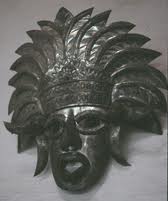
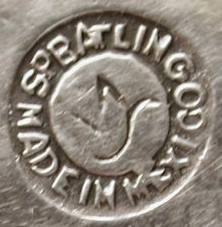
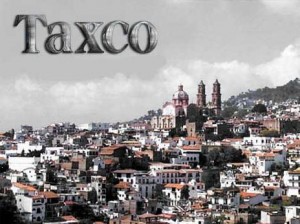



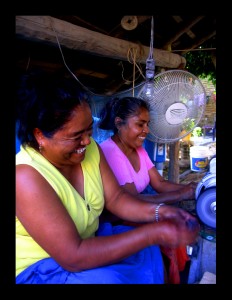



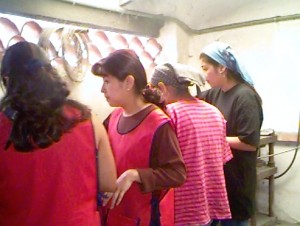
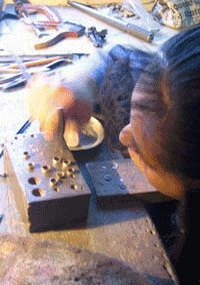

Comments on this entry are closed.